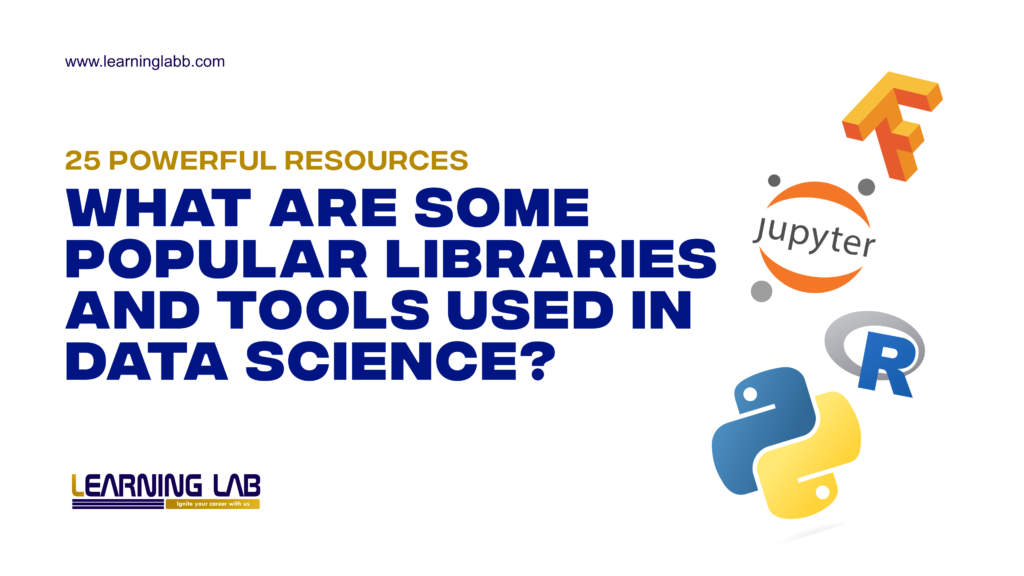In the ever-evolving landscape of data science,what are some popular libraries and tools used in data science are crucial to extract meaningful insights from complex datasets.
Data scientists rely on what libraries and tools do data scientists use more often along with the frameworks to clean, analyze, visualize, and model data effectively.
This article will delve into what are some popular libraries and tools used in data science that are extensively used in data science, providing you with insights into their features, applications, and benefits.
What are Some Popular Libraries and Tools Used in Data Science?
Data science thrives on a plethora of libraries and tools that cater to various stages of the data analysis process. Let’s explore what are some common tools and technologies used in data science as a standout options:
1. Python – The Foundation of Data Science
The first very common and most highly used tool if you search what tools do you use in data science then it’s Python.
Python stands as the cornerstone of data science due to its versatility, extensive libraries, and user-friendly syntax.
Libraries like NumPy, pandas, and scikit-learn empower data scientists with robust data manipulation, analysis, and machine learning capabilities.
2. R – Statistical Analysis Powerhouse
R is renowned for its statistical prowess and visualization capabilities.
With libraries such as ggplot2 and dplyr, data scientists can create insightful visualizations and perform advanced statistical analyses effortlessly answering your doubt about what are some common tools and technologies used in data science.
3. Jupyter Notebooks – Interactive Data Exploration
Jupyter Notebooks provide an interactive environment to create and share documents containing live code, equations, visualizations, and narrative text.
This tool fosters collaborative data exploration and analysis resolving your issue of what libraries and tools do data scientists use more often.
4. TensorFlow – Deep Learning Made Accessible
For deep learning enthusiasts, TensorFlow offers a comprehensive platform to build and train neural networks. Its high-level API, Keras, simplifies complex neural network architectures.
5. PyTorch – Flexibility in Deep Learning
PyTorch is celebrated for its dynamic computation graph and intuitive interface.
It’s a preferred choice for researchers and developers who require fine-grained control over neural network operations.
6. SQL – Managing Relational Databases
Structured Query Language (SQL) remains vital for managing and querying relational databases.
Its capabilities in data retrieval, transformation, and joining are unmatched.
So if you have a query what tools do you use in data science or what are the common libraries used in data science then this can be one for you.
7. Tableau – Data Visualization Excellence
Tableau empowers data scientists to create interactive and visually appealing dashboards.
Its drag-and-drop interface simplifies the creation of complex visualizations.
8. Matplotlib – Custom Data Visualizations
Matplotlib is a widely-used plotting library that offers a high level of customization for creating static, interactive, and animated visualizations.
9. Seaborn – Statistical Data Visualization
Seaborn is built on top of Matplotlib and provides a higher-level interface for creating aesthetically pleasing statistical visualizations.
10. Scrapy – Web Scraping Made Easy
Scrapy is a powerful framework for extracting data from websites. It’s an invaluable tool for collecting data for analysis.
11. NLTK – Natural Language Processing
The Natural Language Toolkit (NLTK) enables data scientists to work with human language data, making it an essential tool for sentiment analysis and language processing tasks.
So if you have question in mind what tools do you use in data science then this one is the answer for this.
12. Spacy – Advanced Natural Language Processing
Spacy is a library designed for advanced natural language processing tasks, offering features like part-of-speech tagging and named entity recognition.
13. Pandas-Profiling – Automated Data EDA
Pandas-Profiling automates the process of exploratory data analysis (EDA), generating comprehensive reports on data quality, statistics, and potential issues.
14. StatsModels – Statistical Modeling in Python
StatsModels is a library that enables data scientists to perform various statistical analyses and modeling, including linear regression, time series analysis, and more.
So if you are in a search of what are the common libraries used in data science then this one you can consider.
15. Power BI – Interactive Business Analytics
Power BI is a business analytics tool that allows data scientists to create interactive visual reports and dashboards with a user-friendly interface.
16. Hadoop – Big Data Processing
Hadoop is an open-source framework for processing and analyzing massive datasets across distributed computing clusters.
17. Spark – High-Speed Data Processing
Apache Spark provides lightning-fast cluster computing for big data processing, making it an ideal choice for real-time analytics.
18. Git – Version Control
Git is an indispensable tool for version control, allowing data scientists to track changes, collaborate seamlessly, and maintain code integrity.
This surely will be answering your question what tools do you use in data science.
19. XGBoost – Extreme Gradient Boosting
XGBoost is a machine learning library known for its efficient gradient boosting implementation, often used in competitive machine learning.
20. LightGBM – Gradient Boosting Framework
LightGBM is another gradient boosting framework that excels in handling large datasets and offers high efficiency in model training.
21. SciPy – Scientific Computing
SciPy builds on NumPy and provides additional functionality for scientific and technical computing, including optimization and signal processing.
22. Plotly – Interactive Data Visualization
Plotly enables the creation of interactive, web-based visualizations that can be integrated into web applications.
23. Caffe – Deep Learning Framework
Caffe is a deep learning framework designed for speed and modularity, often used for image classification and convolutional neural networks.
24. Orange – Data Mining and Visualization
Orange offers a visual programming interface for data mining and machine learning, making it accessible to users without extensive programming knowledge.
25. KNIME – Analytics Platform
KNIME is an open-source platform for data analytics, reporting, and integration, facilitating seamless workflows for data processing and analysis.
So if you are the one geeky data science aspirant searching what are some popular libraries and tools used in data science then you can see this one.
Frequently Asked Questions (FAQs)
Q: What is the significance of Jupyter Notebooks in data science?
Jupyter Notebooks provide an interactive and collaborative environment for data scientists to write code, create visualizations, and explain their analyses in a narrative format. This versatility makes them a preferred choice for data exploration and sharing insights.
Q: How does TensorFlow differ from PyTorch?
While both TensorFlow and PyTorch are deep learning frameworks, TensorFlow emphasizes scalability and production deployment, making it suitable for large-scale projects. On the other hand, PyTorch offers flexibility and dynamic computation, catering to research-oriented tasks.
Q: Can you elaborate on the use of Tableau for data visualization?
Tableau offers an intuitive drag-and-drop interface to create interactive and informative data visualizations. It connects to various data sources, enabling data scientists to transform complex datasets into actionable insights.
Q: What advantages does Git bring to data science projects?
Git provides version control, allowing data scientists to track changes, collaborate with team members, and revert to previous states of the codebase. This ensures code integrity and efficient collaboration.
Q: Why is XGBoost a popular choice in machine learning?
XGBoost is renowned for its efficiency and performance in gradient boosting tasks. Its optimized implementation significantly enhances predictive modeling accuracy and speed.
Q: How does Hadoop handle big data processing?
Hadoop employs a distributed file system and a programming model that divides large datasets into smaller chunks, which are then processed in parallel across a cluster of machines. This approach enables efficient processing of massive datasets.
Conclusion
In the area of data science, the choice of what are some popular libraries and tools used in data science can greatly impact the quality and efficiency of analyses.
From Python’s versatility to TensorFlow’s deep learning prowess, each tool serves a specific purpose in the data science workflow.
By harnessing these tools effectively, data scientists can unlock the potential hidden within complex datasets, driving innovation and insights across various industries.





